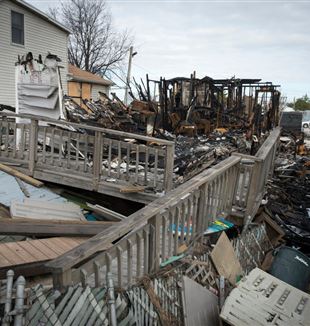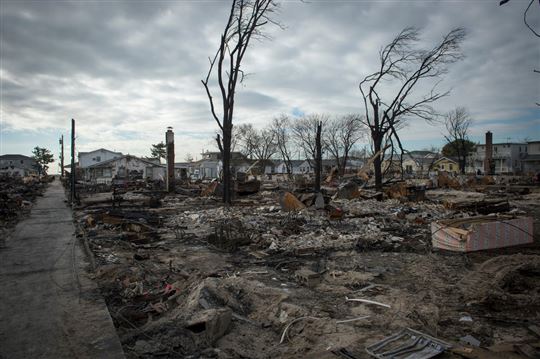
The Solid Foundations of Breezy Point
Sandy and the fire that followed destroyed everything for many families on the strip of land between Brooklyn and the ocean. But what won out among the people is gratitude, because things and people are still there, “even in the destruction.”Sandy was a monster made of water and wind, but what destroyed so many houses on Breezy Point was the fire. While the inhabitants of Manhattan equipped themselves with pumps to remove the muddy water that had invaded the lower floors of buildings, the wooden houses on that narrow strip of Queens between the bay and the ocean were wiped out by flood and flames. The basements were filled by the ferocious tides, and the upper floors exhaled spirals of black smoke, invisible in a night without electric lights. The fire blazed up near the most acute angle of “the Wedge,” a triangle densely packed with streets in the heart of this small town (population: 5,000 year-round residents), which faces the southern coast of Brooklyn. The houses on Breezy Point are so close together that the fire spread instantly, before the eyes of the inhabitants who had decided not to evacuate. This remote corner of New York, traditionally made up of vacation homes of Irish immigrants, some of whom have made it a year-round residence, contains 3 of the 10 volunteer fire stations in the city that were unable to stop the fire–driven by gusts of wind–from carrying out its destruction. The only street that leads to Breezy Point was inaccessible due to flooding, and days went by before help could arrive. In the end, a battalion of Marines was sent to assist the population.
The videos taken from helicopters could easily be confused with images of a war zone after an air raid. A total of 110 houses were annihilated. Many of those that remain are heaps of wooden beams and tangles of shapeless metal. The luckier inhabitants found their homes left crooked or mutilated by the wind and water. When Patrick Duffy, whose family has vacationed and lived on Breezy Point for generations, shows photographs of the disaster, he has to add explanatory captions: “This is a bar.” “This is the back of my house.” “This is the front.” “This is a street.”
Irish accents. The statue of the Virgin Mary, protected by its stone niche, is still there–intact–among the rubble that gave off smoke for days, in front of the house built by Patrick’s great-uncle in the 1950s, when a group of Irish immigrants founded the cooperative of Breezy Point. The inhabitants are the co-owners of the “Irish Riviera,” a community of firefighters and police officers with Irish accents, but also of Wall Street traders, the second most popular profession at Breezy Point. Because of this social mixture, it was the borough of Queens who mourned the most dead (relative to its population) on September 11th, 2001. Those who were not working in the towers of the World Trade Center raced to downtown–often as not with their firefighting squadron–to help after the first plane crashed. Many never returned. What has never abandoned these places, though, is faith, which glimmers in the Marian statues at the intersections of the streets, the packed churches, the summer Masses that are celebrated under the porches of houses. Patrick has traces of Ireland in his name and his features, and men in uniform are not lacking in his family. When he speaks about Breezy Point, there is a certain something in his eyes: “I’ve spent every summer there since I was a kid, and that place is a part of what I am, of my identity. When I was able to reach Breezy Point from Staten Island, to see what had happened, I was petrified, overcome for a moment by despair. Then I saw my uncle, my cousins, neighbors, friends... I saw that they were still there, I saw that things were still there, even in the destruction in front of me, and I was surprised by gratitude.” Gratitude, first of all, because things are still there, and because Sandy, which was responsible for 193 deaths along its march from the Caribbean to Maine, took no victims in Breezy Point. “I saw my family’s house burned, buildings torn from their foundations and moved dozens of yards away, houses split in two, as if a giant had played Jenga with the town. I still ask myself why God allows these things to happen but, at the same time, my experience shows that there is a promise of beauty and of good in reality,” explains Patrick. And he speaks of this as an “opportunity,” a word that seems almost scandalous to use when one looks at the ruins. “In my family, we found ourselves asking, ‘Why do these things happen?’ We thought that we could control everything and, instead, reality forces us to ask once more, ‘Who are You?’ Who are You, who make all things, who give me the greatest joys, and allow the place dearest to me to be destroyed? The initial despair was replaced by this pressing question,” says Patrick.
When life slows. The painful memories of September 11th overlap with fresh images in this community, which founds its hope in an Other. In the church of St. Thomas More, illuminated by candles, the Bishop of Brooklyn, Nicholas DiMarzio, spoke precisely of hope, “the only thing that sustains us.” When Sandy tore through New York, it uncovered the solitude of a city that is both monumental and provisional; it brought into the open the fragility of human relations that operate under the appearance of usual things. The will to react is visible, and how. But one also sees immense gashes of a loneliness that is normally imperceptible because of a strange optical illusion: at normal speed, it seems that everyone in New York has too many people to meet, too many words to say. When the lights go out, when the water doesn’t run from the faucets, when the subway is closed, when the cellars are flooded, then the rhythm of life slows down and, suddenly, the ties between people evaporate among the skyscrapers of Manhattan, the island on which the majority of homes are inhabited by only one person. On Breezy Point, it’s different. “The people don’t know where to stay because they have too many offers of hospitality,” explains Patrick, moved by the humanity that was unleashed in the most tormented corner of the city. The foundations of the people who live on that strip of land are still solid, like that statue of the Virgin Mary, triumphant among the ruins.